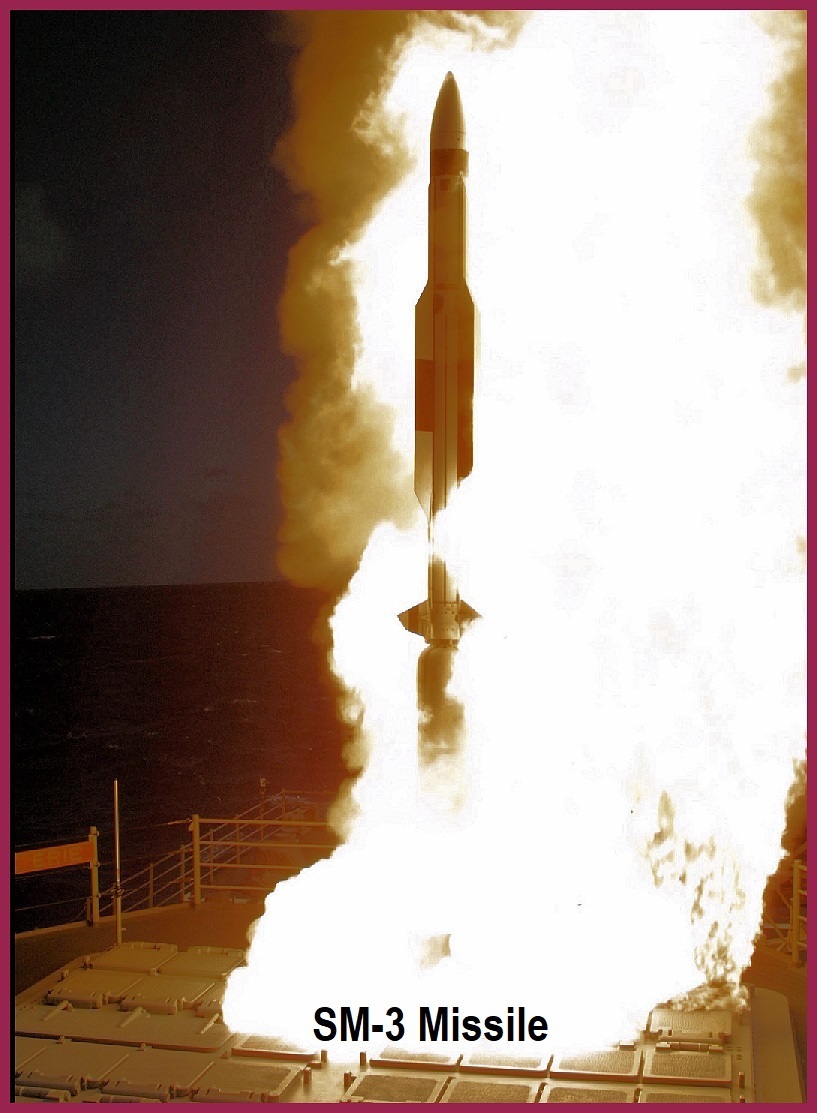
|

|
SM-3 Anti-Ballistic Missile (ABM) Missile
The SM-3 is primarily a ship-based missile used by the United States Navy, and is
specifically designed to intercept short and intermediate range ballistic missiles. It
is an integral part of the Aegis Weapons System. It is also deployed as part of Aegis
Ashore.
The SM-3 evolved from the proven SM-2 Block IV design. The SM-3 uses the same
solid rocket booster and dual thrust rocket motor as the Block IV missile for the
first and second stages and the same steering control section and midcourse missile
guidance for maneuvering in the atmosphere. To support the extended range of an
exo-atmospheric intercept, additional missile thrust is provided in a new third stage
for the SM-3 missile, containing a dual pulse rocket motor for the early
exo-atmospheric phase of flight.
The SM-3 Block IB Interceptor has an enhanced two-color infrared seeker, upgraded
steering and propulsion capability that uses short bursts of precision propulsion to
direct the kinetic missile toward incoming targets.
The next-generation SM-3 Block IIA Interceptor was built by Raytheon Missiles &
Defense in cooperation with Japan. It has two distinct new features:
* larger rocket motors that will allow it to defend broader areas from ballistic missile
threats.
* the interceptor’s kinetic warhead has been enhanced, improving the search,
discrimination, acquisition and tracking functions, to address advanced and
emerging threats.
Steps Of A Ship's Ballistic Missile Engagement
The engagement of a short to intermediate range ballistic missile would
proceed as follows:
01) A ballistic missile is detected by a ship's AN/SPY-1 (3-D) air search radar.
02) The Aegis Weapons System establishes a track and calculates an intercept
solution.
03) When the SM-3 launch order is issued, the Aerojet MK 72 solid-fuel rocket
booster launches the SM-3 out of the ship's Mark 41 vertical launching system (VLS).
04) Communication with the launching ship is established by the missile.
05) Once the booster burns out, it detaches, and the Aerojet MK 104 solid-fuel dual
thrust rocket motor (DTRM) takes over propulsion through the atmosphere.
06) The missile continues to receive mid-course guidance information from the
launching ship's SPY-1 radar uplink and is also aided by GPS data.
07) After the second stage DTRM burns out, it detaches, and the ATK MK 136
solid-fueled third-stage rocket motor (TSRM) fires, and it takes the missile above
the atmosphere (if needed).
08) The TSRM is pulse fired and provides propulsion for the SM-3 until 30 seconds
to intercept.
09) At that point the third stage separates, and the Lightweight Exo-Atmospheric
Projectile (LEAP) kinetic warhead (KW) begins to search for the target using
pointing data from the launching ship.
10) The Aerojet throttleable divert and attitude control system (TDACS) allows
the kinetic warhead to maneuver in the final phase of the engagement. The
KW's sensors identify the target, and attempts to locate the most lethal part of
the target. The KW is steered to that point.
11) If the KW intercepts the target, it provides 130 megajoules (96,000,000 ft⋅lbs.;
31 kilograms of TNT) of kinetic energy at the point of impact.
General Characteristics: SM-3 (ABM) Missile
Used By:
* United States Navy
* Japan Maritime Self Defense Force
Manufacturer:
* Raytheon, Aerojet
* Mitsubishi Heavy Industries (Block IIA)
Mass:
* 1.5 tons
Length:
* 21.5 ft. (6.55 m)
Diameter:
* 13.5 in. (0.34 m) for Block I
* 21 in. (0.53 m) for Block I2
Warhead (Conventional):
* Lightweight Exo-Atmospheric Projectile (LEAP) kinetic warhead
Wingspan:
* 62 in. (1.57 m)
Engine:
* Stage 1: MK 72 Booster, solid-fuel, Aerojet
* Stage 2: MK 104 Dual Thrust Rocket Motor (DTRM), solid-fuel, Aerojet
* Stage 3: MK 136 Third Stage Rocket Motor (TSRM), solid-fuel, ATK
* Stage 4: Throttleable Divert and Attitude Control System (TDACS), Aerojet
Range:
* Block IA/B: 900 km (560 miles)
* Block IIA: 1,200 km range and 900 - 1,050 km ceiling (depending on the type of target)
Maximum Speed
* 3 km/s (Mach 10) Block IA/B
* 4.5-5 km/s (Mach 16-18) Block IIA
Guidance:
* GPS/INS/semi-active radar homing/passive LWIR infrared homing seeker (KW)
Launch Platforms
* Surface Ships
* Aegis Ashore
SM-3 Missile Development Video
Videos are embedded and played in the web page. Click on the arrow in the
center of the window to play the video. If a video fails to play embedded,
try playing it on YouTube® by clicking on the Watch on YouTube link in the
lower left corner of the window.